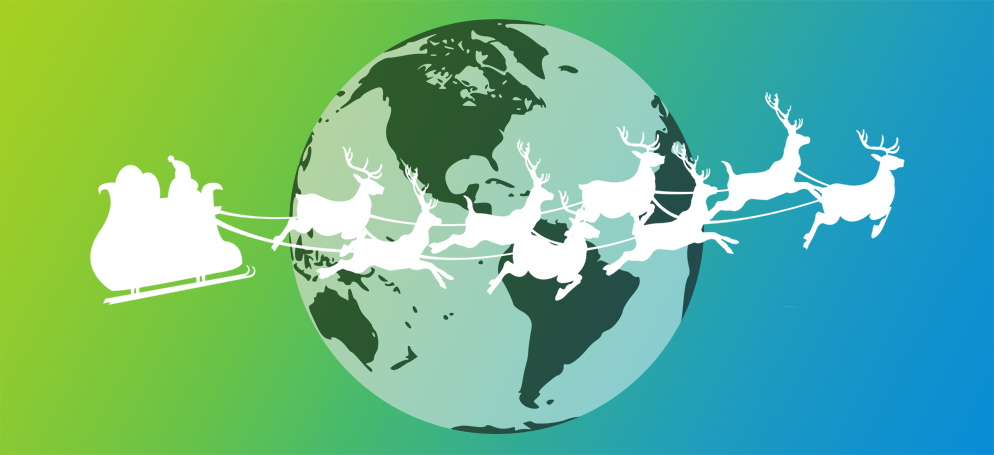
Why Santa offers a masterclass in localisation
With his unrivalled ability to cross borders and enter new markets, we’re big fans of Santa Claus at Oban. Aside from bearing gifts, we feel he offers a valuable insight into localisation – and here’s why.
Santa’s core brand identity
Santa’s image is iconic. Heavily influenced by vintage Coca-Cola ads, he is typically portrayed as an older, cheery, bearded man wearing a red suit with white fur trim. He visits well-behaved children on the evening of Christmas Eve or the early hours of Christmas morning to leave presents for them. Also known as Father Christmas or St Nicholas, he lives in the North Pole, where he is assisted by a team of elves and flying reindeer to help him fulfil his duties.
But Santa is not the only mythical gift-giving figure in town. Many cultures around the world have a similar legend to Father Christmas. Here are some of the more colourful:
Russia – Ded Moroz
Ded Moroz – which loosely translates as “Grandfather Frost” in Russian – is a fictional figure whose folklore is prevalent in Russia, Ukraine and a number of former Eastern bloc countries. He typically appears on New Year’s Eve where he gives children presents accompanied by his granddaughter, Snegurochka. Often portrayed with a long white beard, he wears a fur coat and fur hat and carries a long staff.
Iran – Amu Nowruz
Also known as Papa Nowruz, Amu Nowruz is a fictional figure in Iran who appears at the start of Spring with another figure, Haji Firuz, to commemorate the start of the Iranian New Year, Nowruz. Like Santa, he visits children and gives them gifts – but in contrast, his companion, Haji Firuz, demands gifts instead. He is usually depicted with silver hair and a white beard, a felt hat and a long cloak.
Iceland – Yule Lads
Santa’s equivalent in Iceland is a little more complicated. The Yule Lads – sons of mountain trolls Gryla and Leppaludi – are a group of 13 mischievous pranksters who come to town one by one during the last 13 nights before Christmas. They leave small gifts in shoes that children have placed on windowsills, but for children who have been disobedient they instead leave a potato in the shoe. Somewhat frighteningly, they are sometimes accompanied by the Yule Cat, a vicious big cat who eats people who have not received new clothes to wear before Christmas Eve.
Finland – Joulupukki
Joulupukki is a legendary Christmas figure from Scandinavia whose name loosely translates to “Yule Goat”. In Finland, Joulupukki represents a man who turns into a goat on Christmas Eve. Fortunately for Finnish children, he does not come empty-handed. Accompanied by a chaperone, the goat goes from door to door looking for well-behaved children to give presents to.
Central Europe – Mikulas
In many countries in Central Europe, Szent Miklos or Mikulas is a historical figure similar to St Nicolas. According to legend, Mikulas visits homes on 5th December to reward good children with presents. Children whose behaviour has been less than good receive a wooden spoon or pieces of raw potato instead from Mikulas’ mean assistant, Krampusz.
Italy – La Befana
La Befana, the Italian Christmas witch, combines elements of Santa with Halloween. Her witch-like appearance is deceptive: she’s actually a good housekeeper turned friendly witch, and her story goes back to the time of Jesus Christ’s birth.
Befana delivers presents and sweets to well-behaved children on the night of 5th January. Her mode of transport is her broomstick, which she also uses to sweep away the dust and problems of the previous year. In return, she is given wine.
Japan – Hotei
Santa resembles one of Japan’s seven lucky gods in more ways than a portly stature. Hotei, meaning “a cloth sack,” is the rotund, half-dressed guardian of children (among other things) in Japanese culture. He wears a grin and carries a bag like Santa, but Hotei’s sack contains more than toys and presents – it’s also believed to be full of fortunes, or possibly even weighted down by the world’s woes.
Liberia – Old Man Beggar
In Liberia, Christmas tradition involved a fusion between two cultural icons – the Westernised version of Santa but also a Liberian character called Old Man Beggar. Both Santa and Old Man Beggar would appear during the festive season to entertain children and their parents. Instead of bringing presents, they used their talents to bring joy and happiness to people through entertainment for which they received payment. This was an art form that produced its own unique music, dance and songs.
Old Man Beggar was always dressed in raggedy clothes, while Santa Claus was elegantly dressed in the latest fashions. Old Man Beggar comes from Liberia’s dancing “bush devils” tradition and is sometimes portrayed on stilts or layered in tattered attire and straw.
Hawaii – Kanakaloka
Santa is known as Kanakaloka in Hawaii and doesn’t wear his traditional red and white suit, but instead, the flowery clothing associated with Hawaii. Kanakaloka is a chilled-out figure, which is appropriate, given that Christmas is a time to forget about your troubles and embrace family and loved ones.
. . .
So… you get the idea. At the heart of all these legends is a mythical gift giving figure who brings joy to others (mainly children) at a key celebratory point in the year. Santa is the dominant expression of this figure in our culture but, as with all sensitive examples of localisation, execution around the world varies according to culture and tradition.
To find out how Oban can help you navigate local culture and customs around the world, please get in touch.

Az Ahmed | Marketing Manager
Oban International is the digital marketing agency specialising in international expansion. Our LIME (Local In-Market Expert) Network provides up to date cultural input and insights from over 80 markets around the world, helping clients realise the best marketing opportunities and avoid the costliest mistakes.